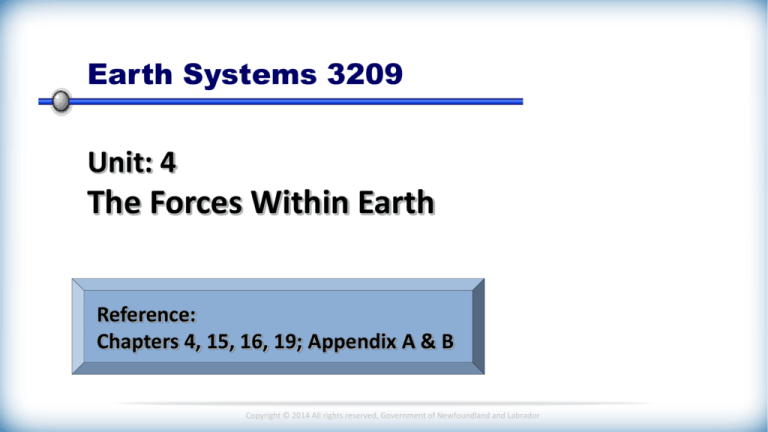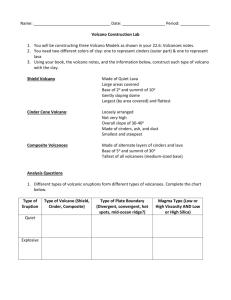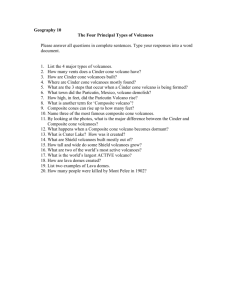
Earth Systems 3209
Unit: 4
The Forces Within Earth
Reference:
Chapters 4, 15, 16, 19; Appendix A & B
Copyright © 2014 All rights reserved, Government of Newfoundland and Labrador
Unit 4:
Topic 5.1
Types of Volcanoes
Focus on . . .
define volcano.
describe the three types of volcanoes based on the following
criteria; width, slope, type of material, size and rock type.
Copyright © 2014 All rights reserved, Government of Newfoundland and Labrador
Types of Volcanoes
Volcano
is an opening in Earth’s crust through which
igneous materials (lava, ash, cinder, and gases)
are erupted.
Three different types of volcanoes exist;
1) Composite
2) Sheild
3) Cinder
Text Reference
Pages 96 - 101
Copyright © 2014 All rights reserved, Government of Newfoundland and Labrador
1. Composite or Stratovolcano
Characteristics:
Large, nearly symmetrical structure formed from
alternating lava flows and pyroclastic debris.
Most active composite cones are in a narrow zone
that encircles the Pacific (Pacific Ring of fire).
These volcanoes are produced by very viscous
(thick) lavas mainly andesitic in composition.
Copyright © 2014 All rights reserved, Government of Newfoundland and Labrador
1. Composite or Stratovolcano
Characteristics:
Display the most violent type of volcanic activity.
Erupting lava and pyroclastic material.
Form a steep sided and relatively narrow base volcano
(up to 20 km wide) compared to shield.
These volcanoes are found in mountainous environments
where oceanic – continental convergence occurs.
Ex. Andes Mountains.
Examples of these volcanoes include;
Mount Mayon in the Phillipines, Mount Fuji in Japan, and
Mount St. HelensCopyright
In the
USA.
© 2014 All rights reserved, Government of Newfoundland and Labrador
Mt. St. Helens – a typical
composite volcano
Copyright © 2014 All rights reserved, Government of Newfoundland and Labrador
Mt. St. Helens following
the 1980 eruption
Copyright © 2014 All rights reserved, Government of Newfoundland and Labrador
2. Shield Volcano
Characteristics:
Broad, slightly domed structure formed from fluid lava flows.
These volcanoes are produced by lavas that display a
low viscosity and are mainly basaltic in composition.
Form relatively wide base volcanoes compared to its
height and are the largest of the three types of volcanoes.
These volcanoes are mainly found on the ocean floor along
divergent boundaries and hot spots.
Examples of these volcanoes include;
Hawaiian Islands (Mauna Loa and Kilauea), & Midway Islands.
Copyright © 2014 All rights reserved, Government of Newfoundland and Labrador
2. Shield Volcano
Copyright © 2014 All rights reserved, Government of Newfoundland and Labrador
3. Ash & Cinder Volcano
Characteristics:
Built mainly of ejected pyroclastic materials, such as,
ash and cinder.
Volcanic cone has a very steep slope that is
usually less than 300 meters high.
Form on the base of larger volcanoes and are
the smallest of the three types of volcanoes.
Example: Paricutin in Mexico.
Copyright © 2014 All rights reserved, Government of Newfoundland and Labrador
A size comparison of the three
types of volcanoes
Shield volcanoes
are the largest reaching up to 100’s of
kilometers wide and up to 4 km above
sea level.
Composite volcanoes
are the second largest ranging in size
from 10’s of kilometers wide and up to
3 km high.
Cinder volcanoes
are the smallest approximately 1 – 2 km
wide and up to 300 meters (1000 ft) high.
Copyright © 2014 All rights reserved, Government of Newfoundland and Labrador
Volcano Type Characteristics
Copyright © 2014 All rights reserved, Government of Newfoundland and Labrador
Example 1:
Which is a characteristic of a shield volcano?
(A)
(B)
(C)
Width of Base
narrow
narrow
wide
Slope
gentle
steep
gentle
(D)
wide
steep
Which type of volcano can be found associated
with oceanic ridges?
(A) cinder
(C) shield
(B) composite
(D) strata
Copyright © 2014 All rights reserved, Government of Newfoundland and Labrador
Example 2:
What are small, steep-sided volcanoes made
of pyroclastic debris called?
(A) calderas
(B) cinder cones
(C) composite volcanoes
(D) shield volcanoes
Copyright © 2014 All rights reserved, Government of Newfoundland and Labrador
Your Turn . . .
Take the time and complete the following questions . . .
(Solutions to follow)
Questions:
Which type of volcano is the smallest with the steepest slope?
(A) cinder
(C) composite
(B) shield
(D) strato
At which location is a composite volcano formed?
(A) convergent plate boundary
(C) hot spot
(B) divergent plate boundary
(D) mid-ocean ridge
Copyright © 2014 All rights reserved, Government of Newfoundland and Labrador
Solutions . . .
Questions:
Which type of volcano is the smallest with the steepest slope?
(A) cinder
(C) composite
(B) shield
(D) strato
At which location is a composite volcano formed?
(A) convergent plate boundary
(C) hot spot
(B) divergent plate boundary
(D) mid-ocean ridge
Copyright © 2014 All rights reserved, Government of Newfoundland and Labrador
Summary . . .
Overview of Points covered:
Volcano
is an opening in Earth’s crust through which igneous are erupted.
3 types of Volcanoes:
1) Composite
2) Shield
3) Cinder
large, symmetrical
alternating lava flows
& pyroclastic deposits
broad
slightly domed
basaltic lava
ejected pyroclastic materials
steeply angled sides
relatively small
Copyright © 2014 All rights reserved, Government of Newfoundland and Labrador







